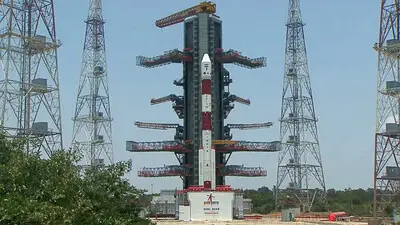The Indian Space Exploration Association (ISRO) is planning for the main Flight Test Vehicle Cut short Mission-1 (television D1) to show the team get away from framework as a component of its human space mission called Gaganyaan.
According to the space organization, it will start automated flight tests for the Gaganyaan mission.
“Preparations for the Flight Test Vehicle Cut short Mission-1 (television D1), which exhibits the presentation of the Group Break Framework, are in progress,” ISRO said.
The first improvement flight Test Vehicle (television D1) is in the last phases of preparation.The Test Vehicle is a solitary stage fluid rocket created for this cut short mission.
“The payloads comprise of the Group Module (CM) and Team Departure Frameworks (CES) with their effective strong engines, alongside CM fairing (CMF) and Connection point Connectors,” ISRO said.
This flight will reproduce the cut short condition during the climb direction relating to a Mach number of 1.2 experienced in the Gaganyaan mission.
ISRO said the Group Break Framework with Group Module will be isolated from the Test Vehicle at a height of around 17 km.
“Subsequently, the cut short succession will be executed independently beginning with the detachment of CES (Team Departure Framework) and sending of the series of parachutes, at last finishing in the protected score of CM (Group Module) in the ocean, around 10 km from the shoreline of Sriharikota,” ISRO said.
The Group Module will house the space travelers in a compressed earthlike barometrical condition during the Gaganyaan mission.
It is in various transformative phases.
For the television D1, the Group Module is an unpressurised adaptation that has finished its mix and testing and is fit to be sent to the send off complex.
This unpressurised Group Module rendition must have a general size and mass of genuine Gaganyaan Team Module and would house every one of the frameworks for the deceleration and recuperation.
With its finished arrangement of parachutes, recuperation helps, incitation frameworks and pyros.
The flight frameworks in Group Module are in a double excess mode design for route, sequencing, telemetry, instrumentation and power.
As per ISRO, the Team Module in this mission is broadly instrumented to catch the flight information for assessment of the presentation of different frameworks.
It will be recuperated after score in the Sound of Bengal, utilizing a committed vessel and plunging group from the Indian Naval force.
The space office said the Group Module after combination went through different electrical testing, at ISRO’s office in Bengaluru, including an acoustic test and was dispatched to the Satish Dhawan Space Center in Sriharikota on August 13.
At Sriharikota, it will go through vibration tests and pre-incorporation with the Team Departure Framework, before conclusive joining to the Test Vehicle at the Platform.
This Test Vehicle mission with this Group Module is a huge achievement for the in general Gaganyaan program as a close total framework is coordinated for a flight test.
The outcome of this dry run will make way for the excess capability tests and automated missions, prompting the primary Gaganyaan mission with Indian space explorers, ISRO said.

